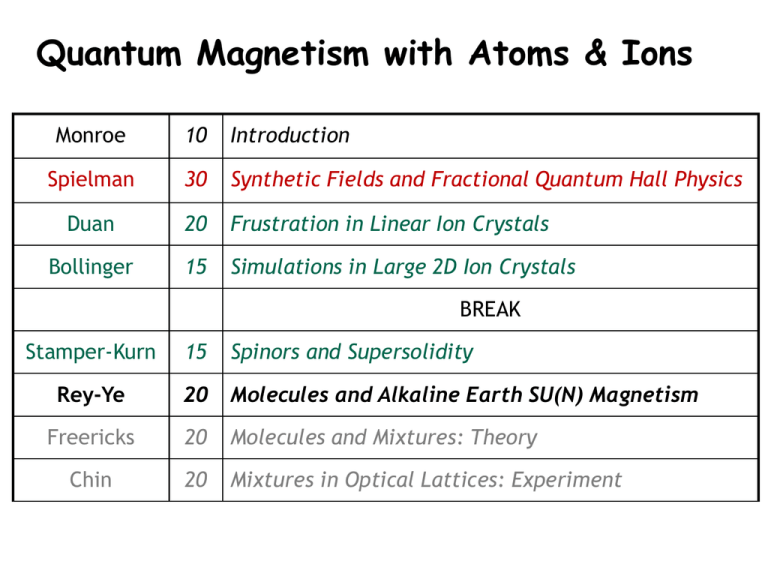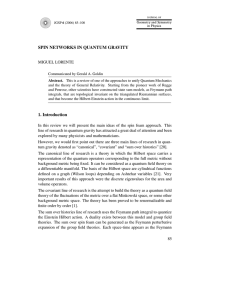DARPA2b3.pptx
advertisement

Quantum Magnetism with Atoms & Ions Monroe 10 Introduction Spielman 30 Synthetic Fields and Fractional Quantum Hall Physics Duan 20 Frustration in Linear Ion Crystals Bollinger 15 Simulations in Large 2D Ion Crystals BREAK Stamper-Kurn 15 Spinors and Supersolidity Rey-Ye 20 Molecules and Alkaline Earth SU(N) Magnetism Freericks 20 Molecules and Mixtures: Theory Chin 20 Mixtures in Optical Lattices: Experiment This TALK: JILA Research Efforts (1) Simulated Quantum Hall Systems (2) Magnetic ordering in multicomponent optical lattices Alkaline earth atoms (3) Quantum magnetism with long range interactions Polar molecules Atomic clock experiments Unique properties • Long lived singlet and triplet states 1S0 (g) and 3P0(e) • J=0 states: Only nuclear spin hyperfine structure, 87Sr has I=9/2 Most accurate measurements of a neutral atom-based optical transition frequency: 1P 1 461 nm (~ 5 ns) 1S 0 =g 3P =e 0 698 nm (~ 150 s) • Cooling down to mK • Trapping in a tight lattice for several seconds • High degree of control over external and internal degrees of freedom Ye group: Science 314, 1430 (2006). PRL 98, 083002 (2007). Science 319, 1805 (2008). PRL. 101, 170504 (2008). -400 -200 P0 Signal (Norm.) 3 1 9 P0 0.062 S0 7 +9/2 +7/2 2 5 2 3 2 0.04 9 0.02 1 2 1 2 σ2 7 2 5 2 200 3 400 Detuning (Hz) hasLaser I=9/2 87Sr 3 0 2 1 2 3 2 5 2 σ+ 1 2 3 2 5 2 -9/2 7 7 2 2 9 9 -7/2 2 2 0.00 -800 -600 -400 -200 0 200 400 600 800 Laser Detuning (Hz) Ludlow et al, Science (2008) Atomic clock experiments Unique properties Few Body Physics Quantum Simulators Quantum Information • Independent optical lattices for the g and e states (Daley et. al, PRL (2008) ). • J=0 implies that nuclear spin decouples from the electron angular momentum. It leads to SU(N) symmetry N=2I+1, since nuclear spin does not participate in collisions (except via Fermi statistics) If at t = 0 only a subset of nuclear spin states is populated, spin states outside it will never be populated. N can be tuned by initial preparation. e.g. N=4 ↑,↓, , A. Gorshkov et al , arxiv: 09052610 • CM Hamiltonias beyond the one band Hubbard→ Charge Spin Orbital • Transition metal oxides , High-Tc superconductivity Heavy fermion materials → Colossal magneto-resistance Quantum criticality Spin liquid phases • Enhanced SU(N) symmetry → No solid state analog • Experimental technologies → Independently manipulate electronic and nuclear degrees of freedom (Not possible with alkaline atoms). Use 1S0 (g) and 3P (e) 0 states as the orbital degrees of freedom Use nuclear spin I as the internal degrees of freedom Load them in the lowest band of corresponding optical lattices For s-wave collisions there are only four interaction parameters Uee=|ee |s Ugg=|gg |s |s : |m1m2 - |m1m2 U s 4a s 2 2m Ueg +=(|eg + |eg )|s Ueg-=(|eg - |eg )|t |t : |m1m2 + |m1m2 dx 3 | W ( x) |2 | W ( x) |2 Ueg+ and Uegare tunable by displacing the lattices Interactions between a conduction band of delocalized electrons and localized magnetic moments via exchange For N=2 H J i , j , t (ci , c j , c j , ci , ) Vex Si i t i Vex= (Ueg+ - Ueg- )/2 SU(N) Kondo lattice model Unit filled deep e-lattice Low density shallow glattice Shell Structure Kondo Insulator Kondo Insulator Vex/Jg Possible Phase Diagram Slow center of mass oscillations Mott insulator with one g atom per site and N=2 AF Ground state: Neel Order Mott insulator with one g atom per site and N > 2 • Need N sites to form a singlet: Like quarks • Extensively degenerate ground state • Large fluctuations can destroy magnetic ordering N 5 Chirial spin liquid Breaks T & P Spin system counterpart of a fractional quantum hall liquid Anyons M. Hemerle, V. Gurarie and AM Rey, PRL (2009) SU(N) Kugel- Khomskii Models Mott phases in transition metal oxides Large N? SU(N) Kondo Lattice Models SU(N) Spin Models Strongly interacting limit? Trap + SU(N): rich physics? Non-equilibrium dynamics? CSL with non-Abelian statistics? Detection? Orbitally selective Mott transitions Dependence of the critical U/J value with N? • Experiment: Prepare a quantum degenerate gas in a 3D lattice Atoms: interactions are isotropic, short-range Polar molecules: anisotropic, long-range + q R - + E d2 (1 -3 cos2 q) ~ k T B R3 Requires: High phase space • Ultra-cold density: nl3 • High density • large dipole moments - log10(density [cm-3]) 12 Carr, DeMille, Krems, Ye, New. J. Phys. (May 2009), Focus Issue on Cold Molecules Dipolar crystal Phase transition & many-body Dipolar quantum gas Quantum information Ultracold Chemistry Molecule optics & circuitry Cold controlled chemistry 9 Novel collisions Fundamental tests Precision measurement 6 log10(temperature [K]) 3 -9 -6 -3 0 A near quantum degenerate gas of polar molecules Control the entire molecular degrees of freedom, including nuclear spins Ultra-cold chemical reactions Dipolar collisions: control elastic/inelastic Ospelkaus et al., Nature Phys. 4, 622 (2008) 40K Fermions 87Rb Bosons Ni et al., Science 322, 231 (2008) Coherent Transfer STIRAP K. Ni et al., Science 322, 231 (2008). Temperature ~ 160 nK T/TF = 1.4 KRb molecules Density ~1012/cm3 (Dipole ~0.5 Debye) r=0.06 d~0.5 D (1011 enhancement) vibration = 0, rotation = 0, total electronic spin = 0, but with nuclear spins!! S. Ospelkaus et al., arXiv 0908.3931 J. Aldegunde et al. PRA 78, 033434 (2008) P. Julienne, arXiv:0812.1233 (2008) Molecule Density (1012 cm-3) (electronic, vibrational, rotational, and hyperfine) Two-body loss n(t ) n(t ) 2 can they decay? nnK 0 T = 230 n(t ) -12 cm3/s β = 4.0(8)x10 1 n 0 t Time (s) Exothermic chemical reactions p-wave collisions Collisional barrier β (p-wave) ∝ T β (s-wave) ∝ const Temp. (mK) s-wave collisions No collisional barrier No suppression Independent of T -1.5 kV distance 1.3 cm +1.5 kV p-wave barrier ml=+1,-1 ml=0 Collisions in 3D will effectively average over the different channels. theory by Quemener and Bohn 80 -5 3 loss rate coeff. 10 cm /s/K) ~d6 (Attractive dipole-dipole interaction) 60 40 =const. (van der Waals interaction) 20 0 0.0 0.1 d (Debye) 0.2 Thermalization of Polar Molecules E 0.6 Tz > Tx (mK) d=0.16 Debye d=0.084 Debye Tx 0.4 Tz 0.2 0 1 2 time (s) 3 4 0.6 0.6 mK) TzTz >> TxTx (m(K) d=0 • Anisotropic 1 • Elastic + Inelastic (long range) 0.4 0.2 1 2 time (s) 3 4 0.5 2 3 time(s) (s) time 0.6 0.6 TzTz mK) < Tx( < Tx (mK) Tz < Tx (mK) 0.2 0.2 0 0.0 0.6 0 0.4 0.4 1.0 4 0.4 0.4 0.2 0.2 0 0.0 1 0.5 2 time (s) time (s) 3 1.0 4 1. 2D quantum gas - Suppress inelastic collisions Only side by side collisions (repulsive interactions) Immediate goals 2. Quantum degeneracy via evaporative cooling 3. Add 2D Lattice + E E 4. Layers Super-solid phases, three body interactions, novel phases… • Correlated Fermi pairs, Bi-layer Bose condensation… … 5. Control of nuclear spin interactions log10(density [cm-3]) Quantum degeneracy Quantum degeneracy Coherent state 12 transfer ~ KBT Enhanced PA? Laser cooling? Buffer-gas Sympathetic cooling? cooling Evaporative cooling? Stark, magnetic, optical deceleration Photoassociation 9 6 log10(temperature [K]) 3 -9 -6 -3 0 For efficient evaporative cooling elastic collision rates must be faster than inelastic quenching rates Main inelastic processes: 1. Spin relaxation processes Avoided : molecules in the lowest hyperfine state 2. Chemical Reactions: Depend on magnitude and orientation of dipole moment, quantum statistics Two-band Hubbard model with SU(N) symmetry and fully controllable parameters J (cˆ t H i, m i , j , , m nˆ Vex =g,e m=-I,...,I i , m i ,m ' Inter-orbital direct V nˆi , g nˆi ,e i cˆ j ,m cˆ j ,m cˆi ,m ) Intra-orbital interaction U nˆ i ,m m ' t V= (Ueg++ Ueg-)/2 Inter-orbital exchange cˆ t t i , gm i ,em ' i , gm ' i ,e , m i , ,m ,m ' cˆ cˆ cˆ Vex= (Ueg+ - Ueg- )/2 Energy 1P 3S w1 (970 nm) Good Franck-Condon for both up and down transitions. Excited state is triplet + singlet mixture w2(690 nm) 6000 K Sr2 Frequency comb (f – stabilized) w1 3S 1S w2 n= 0, N = 0, J = 0 n Inter-nuclear distance R Thermalization of Polar Molecules 0.8 Tx Tz (mK) Tx, Tz (mK) 0.8 0.6 0.4 0.2 0.0 0 time (s) Tx 2 1 2 0.8 Tz 0.6 0.4 E=0 0.2 1 time (s) 2 Tx Tz (mK) Tx, Tz (mK) 0.0 0 d=0.084 Debye time (s) 0.8 0.0 0 0.4 0.2 E=0 1 0.6 0.6 0.4 0.2 0.0 0 d=0.084 Debye 1 time (s) 2







